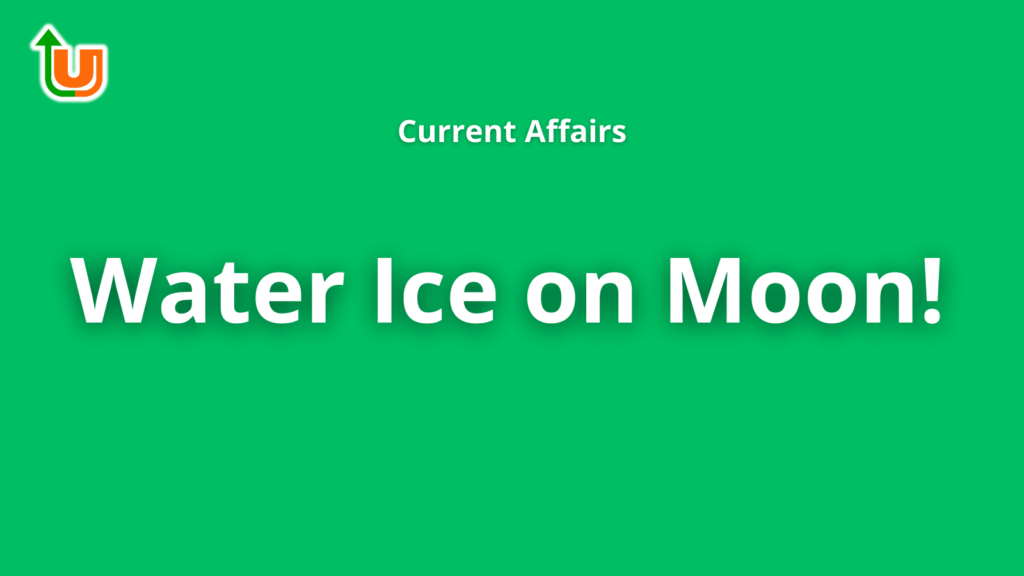A recent study conducted by scientists from the Indian Space Research Organisation (ISRO), in collaboration with researchers from IIT Kanpur, the University of Southern California, Jet Propulsion Laboratory, and IIT (ISM) Dhanbad, has shed light on the presence of water ice within the lunar polar craters. This discovery has significant implications for future space missions and potential human settlement on the Moon.

Table of Contents
Key Findings
- Subsurface Ice Abundance:
- The study reveals that the amount of subsurface ice within the first couple of meters is approximately 5 to 8 times larger than the ice present at the lunar surface in both the northern and southern polar regions.
- This substantial reservoir of water ice makes drilling and sampling from the Moon’s depths crucial for upcoming missions and sustained human presence.
- Regional Variation:
- Interestingly, the extent of water ice in the northern polar region is twice that in the southern polar region.
- The reasons for this regional variation are likely related to geological processes and impact cratering.
- Origin of Lunar Ice:
- The study confirms the hypothesis that the primary source of subsurface water ice in the lunar poles is outgassing during volcanism in the Imbrian period.
- Volcanic activity likely released water vapor, which subsequently condensed and froze in the permanently shadowed craters.
- Research Techniques:
- The research team utilized seven instruments onboard the Lunar Reconnaissance Orbiter, including radar, laser, optical, neutron spectrometer, ultra-violet spectrometer, and thermal radiometer.
- These tools helped analyze the origin and distribution of water ice on the Moon.
- Supporting Evidence:
- The study aligns with a previous investigation by ISRO, which also suggested the presence of water ice in some polar craters using data from the Chandrayaan-2 Dual-frequency Synthetic Aperture Radar instrument.
- Accurate knowledge of water ice distribution is essential for selecting landing and sampling sites for future lunar missions.
Conclusion
The Moon’s hidden water ice reserves hold immense promise for scientific exploration and future lunar colonization. As humanity looks toward the stars, understanding these icy deposits becomes paramount. The study’s comprehensive insights pave the way for ISRO’s ambitious in-situ volatile exploration plans on our celestial neighbour.
View More Sources
(1) New study finds more water ice on Moon within exploitable depths. https://timesofindia.indiatimes.com/home/science/new-study-finds-more-water-ice-on-moon-within-exploitable-depths/articleshow/109751955.cms.
(2) Studies suggest more ice on Moon within exploitable depths, says ISRO. https://www.indiatvnews.com/science/studies-suggest-more-ice-on-moon-within-exploitable-depths-says-isro-2024-05-01-929038.
(3) More ice on Moon within exploitable depths: ISRO, IIT Kanpur study. https://www.msn.com/en-in/news/other/more-ice-on-moon-within-exploitable-depths-isro-iit-kanpur-study/ar-AA1o0nUJ.
(4) Recent studies suggest more ice on the Moon within exploitable depths. https://www.isro.gov.in/Recent_studies_suggest_more_ice_Moon.html.
(5) Studies suggest more ice on Moon within exploitable depths: ISRO. https://m.tribuneindia.com/news/india/studies-suggest-more-ice-on-moon-within-exploitable-depths-isro-616774.
(6) There is more ice on moon subsurface in exploitable depths: Study. https://english.gujaratsamachar.com/news/science-technology/there-is-more-ice-on-moon-subsurface-in-exploitable-depths-study.
(7) undefined. https://doi.org/10.1029/2023JE007745.
(8) undefined. https://doi.org/10.1016/j.isprsjprs.2024.03.020.
Read More:
- Neeraj Chopra: A Golden Throw at Federation Cup 2024
- Sunil Chhetri: A Legend Bows Out from International Football
- A New Dawn: Over 300 Individuals Embrace Indian Citizenship Under CAA
- Pixel Play: HDFC Bank’s Leap into the Future with India’s First Virtual Credit Card
- ‘Lord Curzon Ki Haveli’: A Triumph at the UK-Asian Film Festival
- CJI Chandrachud’s Address at J20 Summit: A Beacon of Transparency and Service





